http://ideas.repec.org/e/pas114.html by Isaac Koomson (PhD)
Moving from the Millennium to the Sustainable Development Goals, 2020
In this chapter, the authors discuss the potential link between mobile money adoption and health ... more In this chapter, the authors discuss the potential link between mobile money adoption and health outcomes, which has not received much attention in the existing literature. They empirically examine the effects of mobile money adoption on healthcare utilisation and spending of rural households in Ghana. Using data from the Ghana Living Standards Survey, the authors show that mobile money adoption enhances rural households’ healthcare utilisation, a finding which is more pronounced in the case of female-headed households. The authors demonstrate that this finding is due to the positive association between mobile money use and the ability of rural households to spend on healthcare.
This paper examines the effects of the various sources of capital and credit available for financ... more This paper examines the effects of the various sources of capital and credit available for financing non-farm enterprises in Ghana. A maximization of the household production function yields linear equations for estimating the key parameters of interest. Capital from bank, family, NGOs and money lenders significantly influence non-farm income. In terms of business expansion, credit from bank, cooperatives and family/friends are very important. Regional differences also appear to be significant as well as the ecological zones. Gender differences in capital and credit sources affect income of non-farm enterprises.

Purpose – This study assesses the effect of time-dynamic financial globalisation uncertainty on f... more Purpose – This study assesses the effect of time-dynamic financial globalisation uncertainty on financial development in 53 African countries for the period 2000-2011.
Design/methodology/approach – Financial globalisation uncertainty is estimated as time-dynamic to capture business cycle disturbances while all dimensions identified by the Financial Development and Structure Database of the World Bank are employed, namely: financial depth (money supply and liquid liabilities), financial system efficiency (at banking and financial system levels), financial system activity (from banking system and financial system perspectives) and financial size. The empirical evidence is based on the Generalised Method of Moments with forward orthogonal deviations.
Findings- The following findings are established. First, financial globalisation uncertainty does not significantly affect money supply, financial system deposits and financial size. Second, the uncertainty increases banking system efficiency, banking system activity and financial system activity. Moreover, the positive effects are consistently driven by above-median uncertainty levels.
Practical implications- It follows that uncertainty in foreign capital flows may be a disguised advantage for domestic financial development, especially in dealing with the substantially documented issue of surplus liquidity in African financial institutions. Moreover, the sceptical view in the financial globalisation literature that ‘allocation efficiency’ is only plausible in the absence of uncertainty/instability is not substantiated by the findings. Justifications for the nexuses and other policy implications are discussed.
Originality/value- To the best of our knowledge this is the first study to assess the effects of financial globalisation uncertainty on financial development in Africa using time-dynamic measurements of financial globalisation uncertainty and all dimensions identified by the Financial Development and Structure Database of the World Bank.
Papers by Isaac Koomson (PhD)
Studies in Educational Evaluation
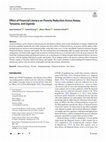
Global Social Welfare
Financial literacy can be critical to reducing poverty, but limited evidence exists on the mechan... more Financial literacy can be critical to reducing poverty, but limited evidence exists on the mechanisms of change. Guided by the financial capability framework, this study examines the direct effects of financial literacy on poverty and the indirect effect through financial inclusion and entrepreneurship, using data from wave 5 of the InterMedia Financial Inclusion Insights Program for Kenya, Tanzania, and Uganda. We also examined how the relationships differ by gender and locality. Overall, the endogeneity-corrected results suggest that an increase in financial literacy is associated with a 6.9% decrease in poverty. We found that entrepreneurship and financial inclusion act as mechanisms of change through which financial literacy decreases poverty, with the findings differing by gender and locality. These findings point to the poverty-reducing effect of financial literacy, mainly in Tanzania, followed by Kenya and Uganda. The results contribute to understanding how financial literacy and poverty interact and can inform contextually relevant interventions and policies.

Social Indicators Research, 2022
In recent years, gambling harm has been considered a significant public health concern due to its... more In recent years, gambling harm has been considered a significant public health concern due to its increasing socioeconomic costs. Although the adverse effects of gambling have attracted research interest, evidence of its effect on financial stress remains largely anecdotal. This study empirically examines the link between individual problem gambling severity and financial stress using panel data from the household, income and labour dynamics in Australia survey. After addressing endogeneity, we find that problem gambling severity is positively associated with self-reported financial stress. Thus, problem gambling severity tends to increase financial stress. This finding is robust to alternative measures of financial stress and gambling behaviour—whether gambling is measured using the problem gambling severity index, gambling risk statuses, number of gambling activities, or gambling expenditure. The positive effect of gambling on financial stress is largely driven by gambling activit...
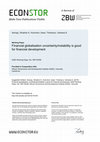
SSRN Electronic Journal, 2015
Die Dokumente auf EconStor dürfen zu eigenen wissenschaftlichen Zwecken und zum Privatgebrauch ge... more Die Dokumente auf EconStor dürfen zu eigenen wissenschaftlichen Zwecken und zum Privatgebrauch gespeichert und kopiert werden. Sie dürfen die Dokumente nicht für öffentliche oder kommerzielle Zwecke vervielfältigen, öffentlich ausstellen, öffentlich zugänglich machen, vertreiben oder anderweitig nutzen. Sofern die Verfasser die Dokumente unter Open-Content-Lizenzen (insbesondere CC-Lizenzen) zur Verfügung gestellt haben sollten, gelten abweichend von diesen Nutzungsbedingungen die in der dort genannten Lizenz gewährten Nutzungsrechte. Terms of use: Documents in EconStor may be saved and copied for your personal and scholarly purposes. You are not to copy documents for public or commercial purposes, to exhibit the documents publicly, to make them publicly available on the internet, or to distribute or otherwise use the documents in public. If the documents have been made available under an Open Content Licence (especially Creative Commons Licences), you may exercise further usage rights as specified in the indicated licence.
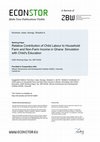
SSRN Electronic Journal, 2015
Child labourers play an integral role in households' income diversification process by contributi... more Child labourers play an integral role in households' income diversification process by contributing to farm and non-farm incomes but policies, including that of the ILO have focused largely on eliminating child labour from the agricultural sector through education. This study sought to ascertain the relative contribution of child labourers to farm and non-farm income using the GLSS6 data and employed a SUR estimation that simulated, empirically, with child's education. Findings showed that as a child labourer spends more time in school, every Gh₵1.00 contributed to farm income is accompanied by a Gh₵2.12 contribution towards non-farm income. By implication, child education policy removes child labourers from the farm but are likely to have a paradoxical effect of pushing these children into non-farm activities as they engage in them after school and during weekends. The suggestion is that governments must provide adequate remuneration for workers and pay a good price for agricultural products so that households do not use children as instruments to diversity their income portfolios, since child labour acts as a push factor in the diversification process.

Review of Economics of the Household, 2022
This paper examines the impact of financial literacy training on household asset accumulation usi... more This paper examines the impact of financial literacy training on household asset accumulation using data collected from a randomised controlled trial implemented in Ghana. Financial assets are measured using account holdings and savings while durable assets and their decomposed components are captured using their total values. After testing for baseline balance, impact is estimated using treatment effect models. We find that financial literacy training plays a significant role in accumulation of both financial and durable assets, but the impact is more evident in the accumulation of productive durable assets. Our overall findings on productive and non-productive assets are robust to alternative conceptualisations of what constitutes productive and non-productive assets. Our results also show that financial literacy training has an impact on the accumulation of both total and productive assets in female-beneficiary households, as well as enhancing account holdings for females, althou...
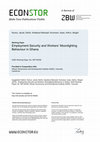
Journal of Economic Studies, 2018
PurposeThe purpose of this paper is to determine the effect of employment security on moonlightin... more PurposeThe purpose of this paper is to determine the effect of employment security on moonlighting in Ghana as a means to inform policy on enforcing issues of employment security.Design/methodology/approachThe paper followed the work of Shishko and Rostker (1976) by applying their approach to the sixth round of the Ghana Living Standards Survey data. The paper created an employment index from four variables and used the ordered logit as the main estimation technique.FindingsThe findings indicated that, as a person with a single job becomes more secured in employment, the likelihood of moonlighting is decreased by 0.03, while for those with two and three or more jobs, the likelihood of moonlighting increased by 0.0297 and 0.0008, respectively, with increasing employment security. This implies that, workers can be made to stick to single jobs by providing them with higher levels of employment security, but once they take on two or more jobs, providing them with employment security wil...
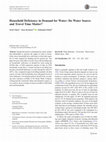
Global Social Welfare, 2017
Despite the massive commitment by policy makers and stakeholders to increase the supply of water ... more Despite the massive commitment by policy makers and stakeholders to increase the supply of water to households, many households have a deficiency in their daily quantity of water required for drinking and for general use. This paper focuses on the effect of water source and travelling time on households' deficiency in demand for water using the GLSS6 data. A Tobit regression analysis of data on 2843 households reveals that a 1 minute increase in travelling time increases household deficiency in water demand by about 8 l (49%). Also, compared to pipe in dwelling/yard/plot, all other sources of water to the households come with greater levels of water deficiency. Government policies should focus on making more resources available to the Ghana Water Company Limited and the Community Water and Sanitation Agency so as to achieve more coverage of water accessible to both urban and rural households.

Social Indicators Research
Although most studies on disease emergencies underscore the need for household readiness for shoc... more Although most studies on disease emergencies underscore the need for household readiness for shocks associated with disease outbreaks, no study to date has provided a holistic measure for profiling households based on their readiness toward disease outbreaks. This paper introduces a novel Disease Outbreak Resilience Index (DORI) using a multidimensional approach that draws on the Alkire-Foster methodology. DORI measures disease outbreak resilience in four dimensions: (a) water and hygiene, (b) physical distancing, (c) energy and communication, and (d) economic security and resilience. The paper details the development of DORI and its use by presenting findings from ten countries in sub-Saharan Africa using data from the Demographic and Health Surveys (DHS) program. In addition to serving as a resilience index, we illustrate how DORI can be used to produce a disease outbreak vulnerability index (DOVI). As a versatile index, the indicators under each dimension can be tailored to meet ...
AARN: Africa (Topic), 2016
This paper attempts to explore crop yield volatility among rural and urban smallholder farmers. T... more This paper attempts to explore crop yield volatility among rural and urban smallholder farmers. The data for the study was sourced from the sixth round of the Ghana Living Standard Survey (GLSS 6). Three separate Ordinary Least Squares (OLS) models were estimated to determine the effect of access to credit, rural farming, and the use of multiple input technology on crop yield. Stochastic Dominance Analysis (SDA) reveals that while rural farmers in the forest and coastal zones experience less volatility in their crop yield, crop yield is highly volatile among rural farmers in the savannah belt. To increase yield among smallholder farmers in Ghana, policy should focus on making credit available to farmers, especially those in the rural areas. Education on the use of technology in farming will help to increase yield and reduce volatility.

Integrated crop-livestock management practices (ICLMPs) play a vital role in ensuring food securi... more Integrated crop-livestock management practices (ICLMPs) play a vital role in ensuring food security and improved welfare for smallholder households, however, studies that focus on ICLMP adoption in Ghana (including its gender dimension) remain scant. This paper examines gender differences in the drivers and intensity of ICLMP adoption using farm-level data from 638 smallholder farmers in Ghana. Employing Multivariate Probit, Tobit regression models and dominance analytical procedures, we find that adoption of ICLMPs is generally influenced by non-farm income, extension contacts and nativity. While age, credit access, soil fertility, distance to markets, total value of assets and research contacts influence the intensity of ICLMP adoption among the men, intensity of adoption among women farmers is influenced mainly by household size. The dominance analysis showed that being a native of the community/village where one farms had the strongest influence in intensifying ICLMP adoption, w...











Uploads
http://ideas.repec.org/e/pas114.html by Isaac Koomson (PhD)
Design/methodology/approach – Financial globalisation uncertainty is estimated as time-dynamic to capture business cycle disturbances while all dimensions identified by the Financial Development and Structure Database of the World Bank are employed, namely: financial depth (money supply and liquid liabilities), financial system efficiency (at banking and financial system levels), financial system activity (from banking system and financial system perspectives) and financial size. The empirical evidence is based on the Generalised Method of Moments with forward orthogonal deviations.
Findings- The following findings are established. First, financial globalisation uncertainty does not significantly affect money supply, financial system deposits and financial size. Second, the uncertainty increases banking system efficiency, banking system activity and financial system activity. Moreover, the positive effects are consistently driven by above-median uncertainty levels.
Practical implications- It follows that uncertainty in foreign capital flows may be a disguised advantage for domestic financial development, especially in dealing with the substantially documented issue of surplus liquidity in African financial institutions. Moreover, the sceptical view in the financial globalisation literature that ‘allocation efficiency’ is only plausible in the absence of uncertainty/instability is not substantiated by the findings. Justifications for the nexuses and other policy implications are discussed.
Originality/value- To the best of our knowledge this is the first study to assess the effects of financial globalisation uncertainty on financial development in Africa using time-dynamic measurements of financial globalisation uncertainty and all dimensions identified by the Financial Development and Structure Database of the World Bank.
Papers by Isaac Koomson (PhD)
Design/methodology/approach – Financial globalisation uncertainty is estimated as time-dynamic to capture business cycle disturbances while all dimensions identified by the Financial Development and Structure Database of the World Bank are employed, namely: financial depth (money supply and liquid liabilities), financial system efficiency (at banking and financial system levels), financial system activity (from banking system and financial system perspectives) and financial size. The empirical evidence is based on the Generalised Method of Moments with forward orthogonal deviations.
Findings- The following findings are established. First, financial globalisation uncertainty does not significantly affect money supply, financial system deposits and financial size. Second, the uncertainty increases banking system efficiency, banking system activity and financial system activity. Moreover, the positive effects are consistently driven by above-median uncertainty levels.
Practical implications- It follows that uncertainty in foreign capital flows may be a disguised advantage for domestic financial development, especially in dealing with the substantially documented issue of surplus liquidity in African financial institutions. Moreover, the sceptical view in the financial globalisation literature that ‘allocation efficiency’ is only plausible in the absence of uncertainty/instability is not substantiated by the findings. Justifications for the nexuses and other policy implications are discussed.
Originality/value- To the best of our knowledge this is the first study to assess the effects of financial globalisation uncertainty on financial development in Africa using time-dynamic measurements of financial globalisation uncertainty and all dimensions identified by the Financial Development and Structure Database of the World Bank.
what we call “microcredit addiction” and provide recommendations that will enable the addicted clients to break away from this craving. The paper reviews literature on social and financial impact of microfinance and finds that failure of microfinance in the delivery of its core
mandate of poverty reduction results in clients’ addiction to micro-credit and, eventually, inhibits their social and financial mobility. The upscaling intentions of MFIs, compulsory savings, high interest rates and transactions costs, multiple borrowing, client’s inability to save
for the future and, surprisingly, clients’ satisfaction with MFIs’ products and services are among the factors that make clients get addicted to micro-credit.
Design/methodology/approach – The paper follows the work of Shishko and Rostker (1976) in using the GLSS6 data by applying the ordered logit estimation technique. An employment security index is created using four variables.
Findings - The findings indicated that as a person with a single job becomes more secure with employment, the likelihood of moonlighting is decreased by 0.03 while increasing levels of employment security for people with two and three or more jobs, on the contrary, increases the likelihood of moonlighting by 0.0297and 0.0008 respectively. This implies that workers can be made to stick to single jobs by providing them with higher levels of employment security but once they take on two or more jobs, providing them with employment security pushes them to even want to moonlight the more.
Originality/value - With current harsh economic conditions in the country and the urgent need for multiple jobs (moonlighting) as a risk coping mechanism, little has been done on the role employment security plays as a catalyst or otherwise. This paper fills the gap by employing a comprehensive index on employment security in the case of Ghana.